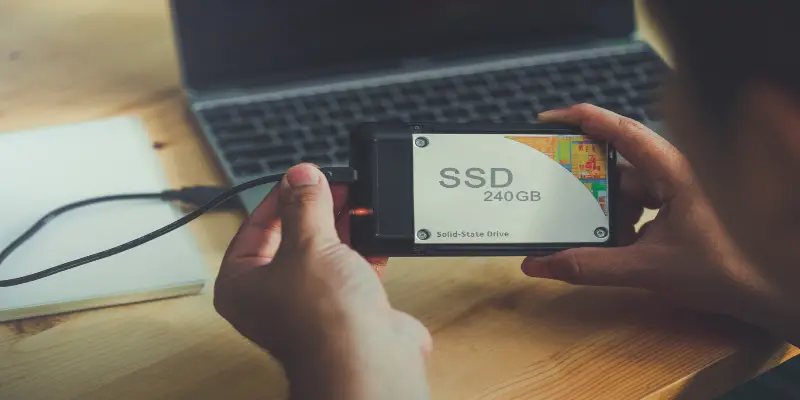Disclaimer: This post may contain affiliate links, meaning we get a small commission if you make a purchase through our links, at no cost to you. For more information, please visit our Disclaimer Page.
SSDs are gaining a lot of popularity these days because of their fast processing speed and instant boot capabilities. But like common hard drives, they are also prone to different types of damage. If an SSD dies somehow, the results can be catastrophic, as users rely on computers to safeguard their important data.
It’s possible to recover data from dead SSD if the SSD died of natural causes (memory cells stopped working). A simple way to recover data from a dead SSD is to simply clone it to a new drive, although you can also connect it to another PC as a secondary device.
This article will help you understand what to do if you want to recover data from a damaged SSD drive. Just keep reading to find out more!
Table of Contents
Is it possible to recover data from dead SSD?
SSD is a disk storage device that offers faster access to data, low power consumption, high performance. The SSD’s shock resistance is higher than the hard drive’s. Since SSDs have no moving parts, they provide high reliability and longevity to their users.
Using proper SSD data recovery software, it is possible to recover data from dead, damaged, corrupted, or damaged SSD drives.
In the first few years, SSDs are reliable and at least for a few years after that depend on a write cycle that could last more than a decade.
SSD drives, unlike conventional hard drives, are not subject to mechanical failure or damage if you drop them to the floor. An SSD drive, on the other hand, could fail due to physical damage or electronic errors, but the chances of this happening are almost zero.
Although there is no easy way to recover data from an SSD that has failed due to electronic or physical damage, you can recover data from an SSD that has logically failed using Stellar Data Recovery Standard.
For example, if the SSD has been burned out due to a power surge, it will be difficult to recover the data. Luckily, some companies are dedicated to fixing this type of situation, they probably won’t have any problem in doing so.
Now, if you open the SSD and see that the memory chips are completely broken, then the damage is irreversible and you won’t be able to recover your data.
Some of the common causes of the death of an SSD disk start with premature wear and tear on the memory cells where it stores its critical data that the controller needs to function, and sudden power loss.
If you’re wondering how an SDD can die, Unlike HDD disks, an SSD disk does not have magnetic plates or other mechanical parts, it only has electronic elements. These elements are the controller and the memory chips where the data is stored.
Also, these 2 elements are on the same printed circuit board, they are not separated as in the case of HDDs. This implies that, if one of the 2 parts fails, whatever it is, the result is the same: the data is inaccessible.
Is it harder to recover data from SSD?
Yes, it is a bit more difficult to recover data from an SSD by its very nature because most SSD models are programmed to “clean” (permanently erase) the free space that remains unused in the file system.
This has serious implications if there is an accidental deletion of files or folders, or when they disappear due to a logical error. In those cases, we run a high risk that the disk will erase any remaining deleted or lost files, causing them to be irretrievably lost.
Remember that when photos or files are lost from a memory card (SD or microSD), it is usually due to two causes: human error or failure of the card itself.
The first type, human absent-mindedness, is usually the most common. Some people mistakenly format the card, or accidentally “delete photos” on the camera.
In addition to this, an SSD is considerably more expensive than a conventional disk of the same capacity. The maximum capacity that you can find today in the market for SSDs is much lower than that available in conventional disks.
I have to mention that certain SSD units are known to suffer from defects in their firmware or their controllers; These failures can render the disk unusable and cause us to lose access to our data.
A positive aspect that you can find in this feature is that SSDs compared to conventional hard drives have a better response speed.
Conventional drives need to spend a considerable amount of time getting up and running.
At first, the motor should start to rotate to move the plates to the optimum speed; the reading parts must leave their first area and move until they are positioned correctly.
Then, for each read or write operation, the “heads” must wait for the rotation of the plates and position themselves in the appropriate sector.
However, on an SSD disk reading or writing data is much faster by working exclusively with flash memory. The time it takes for the drive to activate and be ready to go, almost instantly, is also much shorter.
The useful life of an SSD tends to be the same, In this case, the durability of the SSD would be 3,600 days, or what is the same, 9.86 years of useful life.
Even if we made more intensive use of the device and wrote 100 GB / day on it, its durability would be around 5 years.
How do I get data off a dead SSD?
The first simple way I can advise you to recover data from an SSD to clone it to a new drive, you can also connect it to another PC as another device so users can access it to extract the data.
Read-only implies that you cannot write or erase anything else on the SSD, but you can access the data and copy it to another device.
As I mentioned before, if your SDD died for any other reason, everything will depend on the cause of the failure, and therefore recovering the data might be a lot more complicated.
There are many SSD data recovery tools available that you can use. EaseUS SSD or SysTools Solid State Drive Recovery are some of the software tools I recommend using. They’re high-end products that offer a variety of various powerful functions.
Some of them are free so you can download and install them for free on your computer. Here you have some of the steps to follow to perform SSD data recovery on a Windows computer
First, you need to select “Deleted File Recovery” mode to start to recover data files from SSD, Afterwards, you just select the solid-state drive and click the “Start” button to start scanning the lost data and files.
The software you chose will start scanning the lost data from SSD. If you cannot find your files after the first scan, you need to scan with the “Deep Scan” mode which will search for more files from the SSD.
After scanning, you can check the recovered files from SSD. Preview some recovered photos, select your files and click the “Recover” button to save them to a computer hard drive or another safe storage device.
Once you manage to get your data back, you can try to repair your Dead SSD which is also possible.
The first solution is to update the firmware of the SSD that the manufacturer achieved by opening Windows Explorer and then going to the device manager and install a tool that updates the firmware on your SSD. You can do this in the properties of the damaged SSD
Another solution is to update the Windows Drivers. Windows drivers are out of date when the installed file system on the SSD notifies it doesn’t work anymore.
You just have to open the Device Manager of your computer, go to the properties of your hard drives and click on “Update Driver”. Users can repair their dead SSD by updating SSD firmware or Windows drivers.
You can always prevent that your SDD dies quickly or take care of it more. Here you have some of my recommendations to fix it. It is more effective to prevent a lost, crashed, or dead SSD drive than to deal with its consequences.
Your solid-state drive needs to be handled as if it might fail tomorrow since you cannot predict when your SSD will fail. Backing up data regularly is one of the best ways to deal with data loss scenarios. Whenever your SSD dies, hangs, or fails, you can use that backup file.
Update your antivirus program installed on your system to prevent any kind of virus or malware infection on your SSD.
Don’t ignore any warning, when you have some unknown logic error on an SSD drive.
How long does an SSD retain data?
They usually hold data for about 6-10 years. Unlike traditional hard drives, SSDs have NAND memory that stores data in the form of ones and zeros in their memory cells. Even if you disconnect an SSD from its power, it will not lose its data
The reality is that if you keep the SSD in a cool and dry place, with little humidity, where the temperature does not change much and away from electromagnetic sources, the data that your SSD or pen contains drive can last for many years.
Of course, I’m talking about ideal conditions that are then very difficult to meet, but in general terms, if you are not careful it is likely that you will never find yourself in the position of connecting an SSD that had been in a drawer for years and that the data isn’t there anymore.
Manufacturers don’t hermetically seal SSDs unlike hard drives, so it is always a good idea to keep them in a closed place where dust doesn’t affect them, or at least as little as possible.
A good idea would be to store your SSDs or pen drives in a cardboard box that allows some perspiration in case moisture enters so you can put them inside a closet or drawer to prevent a lot of dust from entering.
Conclusion
A valid backup of your SSD drive is the only way to be sure you don’t lose your important data. In the event that you lose your data, data backup will allow you to recover your files from any previous backups.
When you can’t make a data backup, you can rely on SSD data recovery software and double your chances of recovering failed, locked, or dead SSD files.



